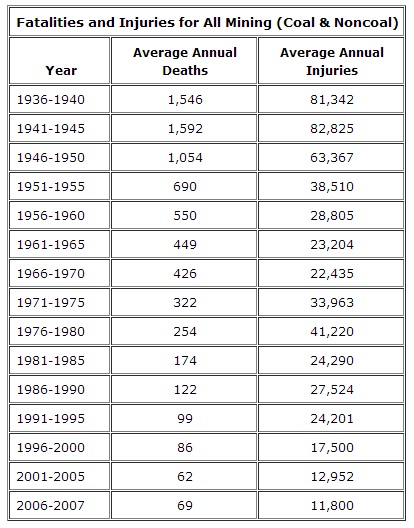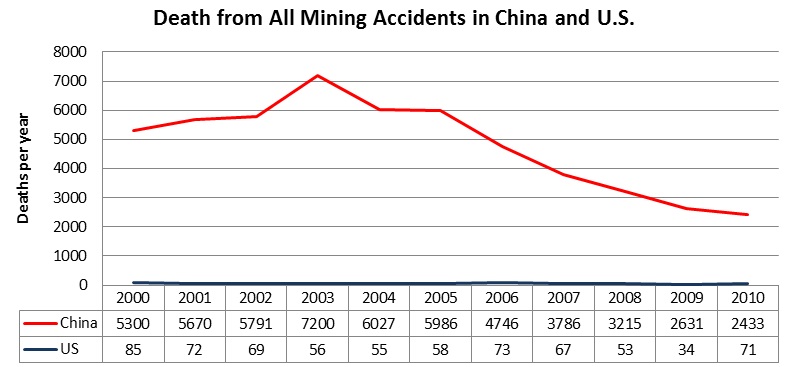Overview
Currently, the only existing regulations on potential environmental and occupational safety issues in the mining industry are those posed by national governments. However, these laws differ from country to country and many companies find ways to circumvent these legal bindings through lobbying, and in some countries, bribing. The lack of international mining safety and environmental standards necessitates a globally accepted protocol that will enforce regulations preventing the contamination of water, air, and soil, and the advent of fatal mining accidents.
The World Trade Organization (WTO) acts to ensure global free trade. While the WTO does mediate international conflict over these commodities, such as in 2009 when China was found to violate international trade rules (Sholts, 2012), the WTO does not resolve conflicts in a timely manner. The time and trade lost during mediation of these disputes causes the economies and industries of all nations to suffer. Such an issue calls for the need to expedite the decision making process of this already established international trade organization.
Problems
The unregulated nature and rapid growth of the strategic mineral industry has generated a number of issues involving the environment, workplace, and international trade. Mission 2016 has identified three impediments to safe, environmentally sound, free-trade driven mining practices:
1. Lack of environmentally-sensitive practices:
For a detailed description of the negative environmental impacts caused by mining, please see the environmental damage page.
2. Occupational hazards:
According to an analysis of injury trends in mining published by the Mine Safety and Health Administration (MSHA), mining fatalities in the U.S. have decreased significantly as mining technology and the general quality of life have improved through time ("Injury trends in,").

However, this decreasing trend in mining accidents is limited to the more developed countries. On average, the death rate per ton of material mined in developed countries is lower than that in developing countries. For example, in 2009 China reported 0.849 deaths per 1 million tons of coal, compared to 0.02 deaths per 1 million tons of coal in the United States ("U.S. coal mining," 2011). It is important to guarantee a safe working environment for miners, because as more mines open up, more health problems will arise.

Caption: Number of deaths from all mining accidents in China and U.S. from years 2000 to 2010. Data adapted from http://www.msha.gov/stats/charts/chartshome.htm.
In an effort to improve working conditions for miners, the International Labour Organization established the Safety and Health in Mines Convention in 1995 (International Labor Organization, 1998). However, only 26 countries have ratified the convention as of November 2012, and that list of nations does not include some powerful mining countries such as China, Chile and Australia.
3. Conflicts in international trade
Due to the unequal distribution of resources around the world, the trade of strategic elements has been a source of tension in the international community. Most recently, In March 2012, the European Union, the United States, and Japan sought WTO action in response to China’s cuts on specific strategic minerals. However, there has been controversy over the effectiveness of getting the WTO to intervene in this issue; a similar case that the United States brought to the WTO regarding China’s cut on exports took a total of thirty months to resolve.
Read more on the international trade page.
Existing policies: Certificates
When coming up with solutions to a complex problem, it is often helpful to look at what others have already tried, and learn why they did not work before. There have been multiple attempts to address the issue of regulation in the past, this section will only focus on two systems; ISO 14001 certification and OHSAS 18001 certification. Mission 2016 considers both of these certifications, why they did not successfully regulate the environmental and occupational safety issues in mining, and offers suggestions for future certification systems.
According to the International Organization for Standardization (ISO), "certification" is defined as "the provision by an independent body of written assurance (a certificate) that the product, service or system in question meets specific requirements" (International Organization for Standardization (ISO)). Certification systems have often been implemented in the past to peacefully resolve "tragedy of the commons" type of problems. For example, when the Marine Stewardship Council offered certificates as proofs of sustainable fishing in the late 1990s, fisheries, eager to convince consumers of their environmental awareness, complied relatively easily to the rules to prevent overexploitation.
The ISO 14001 certification has been used to enforce environmental and mining regulations. This standard specifies requirements for an environmental management system so that the organization can keep track of its environmental performance and successfully develop and implement appropriate policies on its own (ISO, 2002). Since its debut in 1996, companies have been able to be accredited with ISO 14001 as long as they show their commitment to conform by submitting to site and policy reviews, and participating in education and awareness programs (ISO).
The OHSAS 18001 certification has been used to develop occupational health and safety management systems in businesses. This internationally-recognized system stemmed from the British Occupational Health and Safety Advisory Services (OHSAS) in 1999 and has been implemented by companies globally. The OHSAS 18001 checklist addresses issues such as the workers' awareness of emergency procedures and the availability of water in workplace, but as was the case with ISO 14001, it does not quantitatively specify how those procedures should be carried out (Sparey, 2010).
While the generality of the ISO 14001 and OHSAS 18001 does make them applicable to all kinds of organizations, it severely limits the amount of control that is put on the actual performance of individual companies. Achieving a certificate can be analogous to reading a computer manual; you may learn how to assemble your computer and keep your computer virus-free, but the manual will not dictate you how to actually use your computer. Therefore, to a cynic, having a certificate may seem like an excuse so that companies can violate regulations as much as they want as long as they have themselves well-documented (Leavoy, 2011). The standardization organizations put non-automatically renewable expiration dates, which are typically valid for 3 years, on their certificates, and publish new series of standards every 5 years or so to reflect the changes that have since been made in the scientific and political communities, but those measures are often not enough to prevent (or punish) businesses from violating the rules (Burdick, 2010).
The most powerful motivation for businesses in a free market comes in the form of consumers' demands, and most of the time that works out well for the environment (Darnall, 2006). However, for an industry like mining, where the connection between the product and the general public is not so clear, it is more difficult for the certification system to take advantage of the corporations' willingness to please their consumers.
In the previous example of Marine Stewardship Council, the consumers responded quickly to the issues of overexploitation and marine pollution, because the people who purchased the fish product were the general public, and they knew the effect the quality of the fish had on their daily lives. But in this case, people do not commonly buy REE metals directly from the mining companies; and most of them are not interested in the situations of the mines, nor are they aware of the effect the lack of regulation in mining can have on them. So one way to inspire the public, and thereby pressure the corporations to follow the rules, would be to increase the public awareness of the mining environments by using the media, similar to what the documentary, Food, Inc. (2008), or Rachel Carson’s book, Silent Spring, have done in the past.
Please visit the increasing public awareness page for a more detailed solution.
The case study for regulation of REE trade is detailed on this page.
Cost of inaction
A lack of regulation will continue to leave the environment and the welfare of miners at risk. Mining tragedies have been observed in areas all over the world, including Russia, Chile, Africa. These tragedies have brought public outcry from trade union leaders and media outlets. Moreover, besides creating environmental damage, mining has also caused contamination resulting from the leakage of chemicals, which has detrimentally affected the health and wellbeing of local populations. Finally, the current availability and access to strategic minerals has contributed to a high incidence of international conflicts over the trade of these minerals. These issues prevent nations, both developed and developing, from obtaining open access to these strategic materials.
Mission 2016 has identified that these three issues need to be addressed through a greater body that will oversee companies and international trade. This body will ensure that companies do not neglect environmentally friendly practices, and will enforce regulations that will decrease the alarming number of injuries and death that miners have faced. Moreover, it will directly address the international trade of these precious metals promptly and efficiently.
Burdick, D. (2010). Accreditation body and registrar influences. Retrieved from http://www.sustainablesteps.com/registrar-influences.html
(Burdick, 2010)
Darnall , N. (2006). Why firms mandate iso 14001 certification. Manuscript submitted for publication, Business & Society, George Mason University, Fairfax, VA , , Available from Sage Publications. (10.1177/0007650306289387)Retrieved from http://mason.gmu.edu/~ndarnall/docs/Mandating_ISO14001.pdf
(Darnall , 2006)
Humphries, M. Congressional Research Service, (2012).Rare earth elements: the global supply chain(R41347). Retrieved from website: http://www.fas.org/sgp/crs/natsec/R41347.pdf
(Humphries, 2012)
International Labor Organization. (1998, June 05).Ratifications of c176 - safety and health in mines convention, 1995 (no. 176). Retrieved from http://www.ilo.org/dyn/normlex/en/f?p=1000:11300:0::NO::P11300_INSTRUMENT_ID:312321
(International Labor Organization, 1998)
International Organization for Standardization. (n.d.).Certification to iso management system standards. Retrieved from http://www.iso.org/iso/home/standards/certification.htm
(International Organization for Standardization)
International Organization for Standardization. (2002). Iso 14001 environmental management. Retrieved from http://www.iso14000-iso14001-environmental-management.com/iso14001.htm
(International Organization for Standardization (ISO), 2002)
International Organization for Standardization. (n.d.). Iso 14001 - the seven (7) steps to certification. Retrieved from http://www.envirorisk.com.au/userfiles/file/Web site PDFs/SEVEN_STEPS_TO_CERTIFICATION.pdf
(ISO)
Leavoy , P. (2011, August 4). Is iso 14001 certification still relevant?. GreenBiz. Retrieved from http://www.greenbiz.com/blog/2011/08/04/iso-14001-certification-still-relevant?page=0,1
(Leavoy , 2011)
Sholts, P. (2012). China’s monopoly on rare earth metal exports: Slow but necessary progress. Manuscript submitted for publication, National Security Law Brief: American University Washington College of Law, Retrieved from http://nationalsecuritylawbrief.com/2012/11/14/chinas-monopoly-on-rare-earth-metal-exports-slow-but-necessary-progress/
Sparey, T. (2010). Does bs ohsas 18001 work?. BSI Group, Retrieved from http://www.bsigroup.ae/upload/press-releases/18001 Whitepaper.pdf
(Sparey, 2010)
Tang, R., & Morrison , W. M. Congressional Research Service, (2012). China’s rare earth industry and export regime: Economic and trade implications for the united states . Retrieved from website: http://www.fas.org/sgp/crs/row/R42510.pdf
(Tang & Morrison , 2012)
Tse, P.-K., 2009, The mineral industry of China [advance release] in Area reports—International: U.S.
Geological Survey Minerals Yearbook 2007, p. 9.1–9.24, accessed February 17, 2010, at
http://minerals.usgs.gov/minerals/pubs/country/
(Tse, 2009)
Tse, P. U.S. Department of the Interior , U.S. Geological Survey. (2011). China’s rare-earth industry. Retrieved from U.S. Geological Survey website: http://pubs.usgs.gov/of/2011/1042/of2011-1042.pdf
(Tse, 2011)
United States Department of Labor, Mine Safety and Health Administration. (n.d.). Injury trends in mining. Retrieved from website: http://www.msha.gov/MSHAINFO/FactSheets/MSHAFCT2.HTM
("Injury trends in,")
U.s. coal mining deaths: 1990-2011. (2011). Retrieved from http://frankwarner.typepad.com/free_frank_warner/2006/01/us_coal_mining_.html
("U.s. coal mining," 2011)
Xueli, J., & Xiaohui, Z. (2004, November 13). Coal mining: Most deadly job in china. China Daily. Retrieved from http://www.chinadaily.com.cn/english/doc/2004-11/13/content_391242.htm
(Xueli & Xiaohui, 2004)

